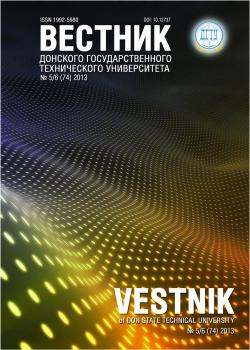The basic principles of the construction and operation of the machine monitoring system in the computer-integrated manufacturing are described. The tool condition and the tooling backup control are the focus of attention. The proposed approach is aimed at creating conditions for the effective functioning, and the tool state management using a knowledge system of TOOL unit of the machine Smart-passport. The unit architecture is presented by a set of modules including a data acquisition module, a module for observing changes in the tool state and control, a monitoring module, and others. The significant innovation of the research is the introduction of the concepts of fuzzy boundary and border lines of sizing wear, and of overall tool life based on the theory of fuzzy knowledge concepts. The introduction of these concepts is related to the necessity to adapt modes of cutting and decision making depending on the tool state and its effect on the part accuracy.
Smart-passport, multioperation machine, tool state monitoring, knowledge system, tool software management, fuzzy boundary resistance.
УДК 004.89+621.518.2
Принципы концептуального подхода к созданию подсистемы ИНСТРУМЕНТ в смарт-паспорте многооперационного станка[1]
А. К. Тугенгольд, А. И. Изюмов
Описаны принципы построения и функционирования системы наблюдения за станками в компьютеризированном производстве. В центре внимания — состояние инструментов и управление инструментальным обеспечением. Предложенный подход ориентирован на создание условий для эффективного функционирования и управления состоянием инструментов с помощью системы знаний блока ИНСТРУМЕНТ смарт-паспорта станка. Архитектура блока представлена совокупностью модулей, в число которых входят регистрирующий модуль, модуль наблюдений за изменениями состояний инструментов и управления, модуль мониторинга и др. Новация данной работы — введение понятий нечеткой границы и пограничных полос размерного износа и общей стойкости инструментов на базе представлений теории нечетких знаний. Использование этих понятий связано с необходимостью адаптации режимов резания и принятия решений в зависимости от состояния инструмента и его влияния на точность обработки детали.
Ключевые слова: смарт-паспорт, многооперационный станок, мониторинг инструментов, система знаний, управление инструментальным обеспечением, нечеткая граница стойкости.
Введение. Многооперационные станки с ЧПУ, или обрабатывающие центры, — типичные образцы современных технологических объектов автоматизированного производства. Эти станки предназначены для комплексной механической обработки большого числа поверхностей за одну
1. Tugengold, А.К., Lukyanov, E.A. Intellektualnyye funktsii i upravleniye avtonomnymi tekhnologicheskimi mekhatronnymi obyektami. [Intellectual functions and management of autonomous mechatronic technological objects.] Rostov-on-Don: DSTU Publ. Centre, 2013, 203 p. (in Russian).
2. Tugengold, А.К. Smart-Passport otkrytoy mekhatronnoy tekhnologicheskoy sistemy. Kontent. [Smart-Passport of open mechatronic technological objects. Content.] Intellektualnaya elektronnaya dokumentatsiya. [Intelligent electronic documentation.] Saarbrucken: Lambert Academic Publishing, 2013, 83 p. (in Russian).
3. Samodurov, G.V., et al. Printsipy postroyeniya intellektualnoy elektronnoy dokumentatsii stanka. [Design concept of machine intelligent electronic documentation.] Stanki, instrument. 2012, no. 7, pp. 15-20 (in Russian).
4. Tugengold, А.К., Berdichevskiy, A.A. Smart-pasport mekhatronnogo tekhnologicheskogo obyekta. Kontsept. [Smart-passport of mechatronic production facility. Concept.] Vestnik of DSTU, 2012, no. 7, pp. 33-41 (in Russian).
5. Paley, S.M. Nekotoryye osobennosti ekspluatatsii tokarnykh stankov s ChPU na uchastke ASV-20. [Some operation features of CNC lathes on site ASV-20.] Avtomatizirovannyye uchastki iz stankov s ChPU, upravlyayemyye EVM: sb. statey. [Automated computer-controlled areas of CNC machines: coll.of papers.] Moscow: ENIMS, 1998, pp. 27-31 (in Russian).
6. Grigoriev, S.N., Gurin, V.D., Tcherkasova, N.Y. Povysheniye proizvoditelnosti frezerovaniya s pomoshchyu diagnostirovaniya sostoyaniya instrumenta s uchetom dostovernosti otobrazheniya sostoyaniya obyekta po kriteriyu yego otkaza. [Increase of milling efficiency by means of diagnosis of the cutting tool’s conditions into account reliability of display of an object state by failure criteria.] Vestnik MSTU “STANKIN”, 2011, no. 3 (15), pp. 44-48 (in Russian).
7. Kocherovskiy, E.V., Likhtser, G.M. Diagnostika sostoyaniya instrumenta po silovym kharakteristikam protsessa rezaniya. Obzor. [Diagnostics of tool state by spower characteristics of cutting process. Overview.] Moscow: VNIITEMR, 1988, iss. 7, 40 p. (in Russian).
8. Hernendez, J., et al. Sensor Fused Intelligent Monitoring System for Machining (SIMON) project from Intelligent Manufacturing Systems (IMS). Final Report. European IMS-SIMON consortium. Available at: http://www.ims.org/wp-content/uploads/2012/11/2.4.32.2-Final-Report-SIMON.pdf (accessed: 03.03.2014).
9. Tugengold, А.К., Kuzmin, A.A. Modelirovaniye bazy znaniy sistemy upravleniya mekhatronnym obyektom. [Modeling knowledge base of mechatronic object management system.] Izvestiya vysshikh uchebnykh zavedeniy. Severo-Kavkazskiy region. Tekhnicheskiye nauki. Spetsialnyy vypusk «Mekhatronika. Sovremennoye sostoyaniye i tendentsii razvitiya». [Technical sciences. Special iss. “Mechatronics. Modern state and development trends.”] 2009, pp. 69-73 (in Russian).
10. Makarov, A.D. Iznos i stoykost rezhushchikh instrumentov. [Wear and durability of the cutting tools.] Moscow: Mashinostroyeniye, 1976, 278 p. (in Russian).
11. Sinopalnikov, V.A., Grigoryev, S.N. Nadezhnost i diagnostika tekhnologicheskikh sistem: uchebnik. [Reliability and diagnostics of technological systems: textbook .] Moscow: Vysshaya shkola, 2005, 343 p. (in Russian).
12. Vallejo, A.-J., Morales-Menéndez, R., Alique, J.-R. On-line Cutting Tool Condition Monitoring in Machining Processes using Artificial Intelligence. Robotics, Automation and Control, ed. by Pavla Pecherková, Miroslav Flídr, Jindřich Duník. Vienna: I-Tech, 2008, 494 p.
13. Bagci, E. Monitoring and analysis of MRR-based feedrate optimization approach and effects of cutting conditions using acoustic sound pressure level in free-form surface milling. Scientific Research and Essays, 2011, vol. 6 (2), pp. 256-277.
14. Vysokoproizvoditelnaya obrabotka metallov rezaniyem. [High-performance metal cutting.] AB Sandvik Coromant, « Sandvik-MKTS», JSC. Moscow: Poligrafiya, 2003, 301 p. (in Russian).





